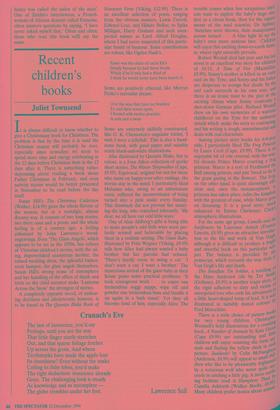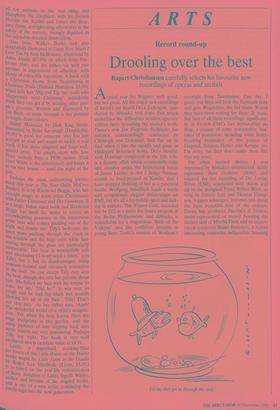Recent children's books
Juliet Townsend
It is always difficult to know whether to give a Christmassy book for Christmas. The problem is that by the time it is read the Christmas season will probably be over, especially since nowadays we seem to spend more time and energy celebrating in the 12 days before Christmas than in the 12 days after it. There is something rather depressing about reading a book about Father Christmas in February, and even nativity stories would be better presented in November to be read before the day itself.
Susan Hill's The Christmas Collection (Walker, £14.99) gives the whole flavour of the season, but in a nostalgic, almost dreamy way. It consists of two long stories, two short ones and a poem, and the whole feeling is of a century ago, a feeling enhanced by John Lawrence's wood- engravings. Even 'The Glass Angels', which appears to be set in the 1950s, has echoes of Victorian children's stories, with the ail- ing, impoverished seamstress mother, the ruined wedding dress, the splendid basket- work hamper, the glass angels themselves. Susan Hill's strong sense of atmosphere and her handling of the effect of death and birth on the child narrator make 'Lanterns Across the Snow' the strongest of stories.
A completely opposite mood, of endear- ing dottiness and idiosyncratic humour, is to be found in The Quentin Blake Book of Nonsense Verse (Viking, £12.99). There is an excellent selection of poets, ranging from the obvious masters, Lewis Carroll, Edward Lear, and Hilaire Belloc, to Spike Milligan, Harry Graham and such unex- pected names as Lord Alfred Douglas, whom I had never suspected of this partic- ular brand of humour. Some contributions are robust, like Ogden Nash's:
Fame was the claim of uncle Ed's Simply because he had three heads. Which if he'd only had a third of I think he would never have been heard of.
Some are positively ethereal, like Mervyn Peake's surrealist dream:
O'er the seas that have no beaches To end their waves upon, I floated with twelve peaches, A sofa and a swan.
Some are extremely skilfully constructed, like G. K. Chesterton's exquisite triolet, 'I wish I were a jellyfish'. This is also a hand- some book, with good paper and suitably scatty black-and-white illustrations.
Also illustrated by Quentin Blake, but in colour, is a Joan Aiken collection of quirky short stories, The Winter Sleepwalker (Cape, £9.99). Equivocal, original but not for those who insist on happy-ever-after endings, the stories stay in the mind. I particularly liked Melusina who, owing to an unfortunate curse, suffered the inconvenience of being turned into a pink snake every Sunday. This drawback did not prevent her marry- ing the king, who remarked tolerantly, 'My dear, we all have our odd little ways.'
One of Alan Ahlberg's gifts is being able to make people's odd little ways seem per- fectly normal and believable by placing them in a realistic setting. The Giant Baby, illustrated by Fritz Wegner (Viking, £9.99) tells how Alice had always wanted a baby brother but her parents had refused. 'There's hardly room to swing a cat.' I don't want a cat, I want a brother.' The mysterious arrival of the giant baby in their house poses some practical problems: 'It took courageous work . . . to unpin one tremendous soggy nappy, wipe off and powder one tremendous bum and bundle it up again in a bath towel.' Yet they all become fond of him, especially Alice. The trouble comes when less scrupulous ests want to exploit the baby's huge size, first as a circus freak, then for the exPeri" ments of the mad scientist, Dr Splitter. 'Switches were thrown, dials manipulated, screws turned . . . A blue light lit up the baby's ever more anxious face.' Children will enjoy this exciting down-to-earth fanta- sy, where right naturally prevails. inter- Robert Westall died last year and his last novel is an excellent war story for children of 10-13, A Time of Fire (Macmillan, £9.99). Sonny's mother is killed in an earlY raid on the Tyne, and Sonny and his father are desperate to avenge her death. Iii the end each succeeds in his own way, arid there is an ironic twist to the plot at the exciting climax when Sonny confronts 3 shot-down German pilot. Richard West"'' drew on his own memories of a wartime childhood on the Tyne for the authentic details which make the story so convincing, and his writing is tough, unsentimental and deals with real characters.
Among picture story books for 6-8-year olds, I particularly liked The Frog Princess by Laura Cecil (Cape, £9.99). There is en enjoyable bit of role reversal, with the wist- ful dreamy Prince Marco courting a frog princess. Marco is a sort of Ferdinand the Bull among princes, and just 'loved to lie in the grass gazing at the flowers'. The fr' on the other hand, is quite alarmingly etti" cient and, once the metamorphosis re princess has taken place, rules the kingrlein with the greatest of ease, while Marco Pe's,. on dreaming. It is a good story, muc'' enhanced by Emma Chichester Clarles atmospheric illustrations. For the same age group, Camille and the Sunflowers by Laurence Anhelt (Frances Lincoln, £8.99) gives an attractive introdue- tion to the life and work of Van (log' although it is difficult to produce a brig°. and cheerful book on this particular sub- ject. The balance is provided by thef postscript, which recounts the true facts , Van Gogh's life and death. The Steadfast Tin Soldier, a retelling _ff the Hans Andersen tale by Tor Seicnef (Gollancz, £8.99) is another tragic storY, the rigid adherent to duty and victinl ° unrequited love who ends his adventures aso a little heart-shaped lump of lead. It is We illustrated in suitably muted colours bY Fred Marcellino.
There is a wide choice of picture for very young children. Christoplle' Wormell's bold illustrations for a colintinng book, A Number of Animals by Kate Grenie (Cape £9.99) are outstanding and children will enjoy counting the farru alich mals and finding the yellow chick in n8,11 picture. Suddenly! by Colin McNaughteu,, (Anderson, £8.99) will appeal to small eed dren who like to be pleasurably frighten c, by a voracious wolf who never quire slid,- ceeds in catching a little pig. A more se j° by ing bedtime read is Humphrey Th4:99), Camilla Ashforth (Walker Books, Many children prefer stories about aniina'' ed toy animals to the real thing and Humphrey the Elephant, with his friends Horatio the Rabbit and James the Bear, have funny, unfrightening adventures in the safety of the nursery, lovingly depicted in the enjoyably detailed illustrations. Also from Walker Books and also delightfully illustrated is Guess How Much I Love You by Sam McBratney, illustrated by Anita Jeram (£7.99), in which little Nut- brown Hare and his father vie with one another in expressions of affection, with plenty of enjoyable repetition. A book with a Christmas theme from Scandinavia is Christmas Trolls (Hamish Hamilton, £8.99), Which tells how Mig and Tig, two trolls who desperately want Christmas', mistakenly think they can get it by stealing other peo- ple's presents. Written and illustrated by Jan Brett, its main strength is the pictures in bright clean colours. Happy Mouseday by Dick King Smith, illustrated by Peter Kavanagh (Doubleday, 48.99) is good for someone who has just learned to read and wants to tackle a real book. It has three chapters and large well- spaced print. The simple story tells how Peter secretly buys a PEW mouse (Pink R yed White to the uninitiated) and keeps it in his tree house — until the night of the gale.
Perhaps the most outstanding picture book this year is The Bear (Julia McCrea rBooks). It is by Raymond Briggs, who has brought magic to many other Christmases With Father Christmas and The Snowman. It IS a large, Babar-sized book and Raymond Briggs has used the space to create an overwhelming presence in the mysterious Polar bear who comes padding out of the night and climbs into Tilly's bedroom: the great paws pushing through the crack in the window and the huge calm white face staring through the glass are particularly memorable. The bear is wonderfully soft and enveloping CI wont need a duvet,' says Tilly), but it has its disadvantages, being u. nh°use-trained and extremely overactive in the bath. No one except Tilly ever sees the bear, though she tells her parents about huh: 'He licked my face with his tongue to Wake me up.' Did he?' It was ever so rough and he had big black wet nostrils blowing hot air in my face."Tilly! That's not very nice.' As her father says, `Aaah! Th. e wonderful world of a child's imagina- tion., Yet, when the bear leaves, there are huge footprints in the garden, and the misty pictures of him slipping back into arctic waters are very convincing. Perhaps Tiny was right. The book is very well produced and is excellent value at £9.99. Lastly, a paperback stocking-filler for lovers of the Little House on the Prairie by might be Little Farm in the Ozarks oy Roger Lea MacBride (Lions, £3.99.) It is based on the real-life reminiscences °f Rose, daughter of Laura Ingalls Wilder, author and heroine of the original books, and is one of a new series continuing the family saga into the next generation.



































































 Previous page
Previous page